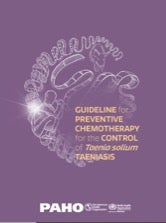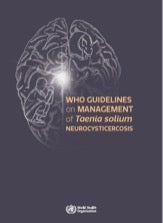
Two guidelines are now available to assist health care providers in appropriate, evidence-based management of neurocysticercosis, and public health stakeholders in implementing control measures for T. solium.
1- Guideline for preventive chemotherapy for the control of Taenia solium taeniasis
This document provides several tools are available for the control of Taenia solium. Preventive chemotherapy for Taenia solium taeniasis, which is directed at the adult tapeworm, is one of them. Other tools focus on pig management, pig vaccination and treatment, sanitation and hygiene, and community education.
Three potential drugs—niclosamide, praziquantel, and albendazole—have been considered for use for preventive chemotherapy in Taenia solium taeniasis control programs through mass drug administration or targeted chemotherapy. In this Guideline, we provide recommendations for preventive chemotherapy in Taenia solium-endemic areas using niclosamide, praziquantel, or albendazole, including at which dose and in which population groups.
The recommendations are intended for a wide audience, including policymakers and their expert advisers, and technical and program staff at governmental institutions and organizations involved in the planning, implementation, monitoring, and evaluation of preventive chemotherapy programs for the control of Taenia solium.
(Click on the image to download the guideline).
| Versão em Português | Version française |
2- WHO Guidelines on management of Taenia solium neurocysticercosis
Neurocysticercosis (NCC) refers to the development of T. solium cysts in the human central nervous system, which may cause focal epilepsy, epileptic seizures, hydrocephalus, chronic headaches, focal deficits, and symptoms due to intracranial hypertension. NCC is one of the leading causes of preventable epilepsy worldwide. The total number of people suffering from NCC, including symptomatic and asymptomatic cases, is estimated to be between 2.56–8.30 million. However, these numbers may be underestimates due to poor access to diagnostic tests in groups at highest risk.
The internationally recognized criteria for the diagnosis of NCC require neuroimaging techniques such as computerized tomography and/or nuclear magnetic resonance imaging, ideally supported by serology. These diagnostic methods are not available in all settings, especially in rural areas of low-income countries, making it difficult to identify and treat patients. Additionally, there is controversy regarding the role, type, and duration of anthelminthic, anti-inflammatory, and antiepileptic drug (AED) treatments required to treat different forms of NCC.
These guidelines were developed to assist health care providers in appropriate, evidence-based management of parenchymal NCC. They aim to improve decision-making to allow appropriate patient care, and to avoid misdiagnoses and inappropriate treatment of patients with NCC.
(Click on the image to download the guideline).





